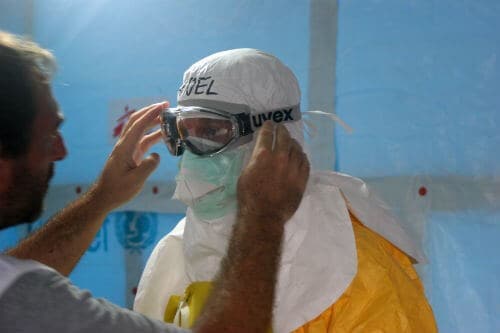Only two lab-confirmed Ebola cases were reported from the outbreak region last week, both in Guinea and both linked to a known transmission chain in Conakry, the World Health Organization (WHO) said today in its weekly update.
In Sierra Leone, the preliminary investigation into an isolated case detected the previous week in Bombali district suggests that a survivor was the source of the Ebola virus that killed a 16-year-old girl. During the same week the country had reported four cases in a cluster in Kambia district.
The WHO said the number of weekly cases has remained below 10 since the end of July, with transmission limited to several small areas in Guinea and Sierra Leone, which it says is indicative of the third phase of the epidemic, with a new response phase to target it.
Case details
The WHO said Guinea’s two new cases involve a 10-year-old girl who traveled from Conakry to Forecariah district and a 24-year-old woman whose illness was detected in the capital city. Though neither was on contact lists, both have strong epidemiologic links to a probable Ebola case-patient who died at the end of August.
The girl died from her infection, and the woman is receiving care in an Ebola treatment center, the WHO said. Responders have identified 500 contacts in their investigation into the two cases.
Prior to the two detections, Guinea had gone 14 days without a case, the WHO said.
Investigations into both cases involved genetic sequencing, which suggested that they are part of a transmission chain in the Ratoma part of Conkary, the only known active chain in Guinea in the last 21 days.
Meanwhile, responders in Sierra Leone have identified 700 contacts of the Bombali teen who died from her infection.
Big picture view
The WHO said the third phase of the response is designed to drive cases down to and keep them at zero. Strategies include enhanced surveillance to quickly identify reintroduction of the virus or any reemergence related to a survivor harboring the virus. It added that the response phase also includes counseling for survivors and increased use of new technologies, such as vaccines and rapid tests.
Efforts are also under way to monitor and evaluate the effect of the phase 3 response steps, the WHO said.
Overall, the totals in the outbreak region are at 28,295 confirmed, probable, or suspected cases and 11,295 deaths, the WHO said. No new healthcare worker infections were reported last week, keeping those totals at 881 infections, 513 of them fatal.
More funds for countermeasures
Inovio Pharmaceuticals announced this week that the US Defense Advanced Research Projects Agency (DARPA) has exercised a $24 million option to continue work on developing Ebola treatments and a vaccine. The Plymouth Meeting, Pa., company said in a Sep 21 statement that the option is part of a $45 million DARPA grant announced in April, which resulted in an initial $21 million for Inovio. The option for the extra $24 million was based on its completion of certain milestones.
The DARPA-funded program, led by Inovio, includes a DNA-based vaccine against Ebola, a DNA-based monoclonal antibody treatment, and a conventional monoclonal antibody treatment.
Inovio said it has enrolled 75 volunteers for a phase 1 clinical trial of its Ebola vaccine, INO-4212, with safety and immune response data expected in the fourth quarter of 2015. In May, the company announced the launch of a phase 1 trial of its DNA-based monoclonal antibody treatment.
The projects are part of DARPA’s multifaceted approach to products to prevent and treat Ebola.
Macaque study suggests lower virulence
The Makona Ebola strain responsible for West Africa’s outbreak seems to cause less severe disease in macaques than the virus that caused the first Ebola outbreak in 1976, according to researchers from the National Institutes of Health Rocky Mountain Laboratories in Hamilton, Mont.
The team published its findings yesterday in Emerging Infectious Diseases.
The investigators infected three monkeys with the Makona strain and three with the original outbreak strain, then compared their clinical parameters. Similar disease features such as fever were seen in both groups of animals, but disease progression was delayed in the ones who received the current outbreak strain.
Although clinical scores were similar for both groups, the Makona-infected animals reached the euthanasia stage 2 days later than those infected with the older strain. The team observed that the Makona group had less pronounced macular cutaneous rash, slightly lower viremia during end-stage disease, smaller rises in liver enzymes, and slightly delayed proinflammatory and chemokine responses.
Though virulence in the newer strain seemed to be less, the disease was still severe or fatal for both groups of animals, the group reported.
The findings seem to track with the lower case-fatality rate for the newer strain, the researchers wrote, though they add that it’s difficult to say if the seemingly lower virulence in humans is reflected in a macaque model, given how severe the disease was for both groups.
They noted, though, that the macaque model could be useful for developing drugs and vaccines against the outbreak strain.


